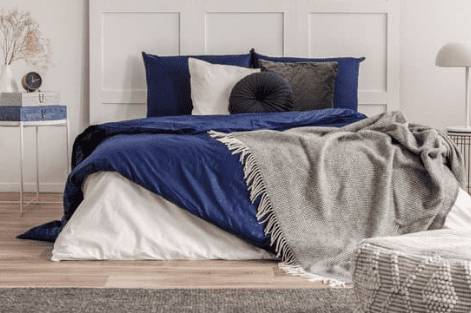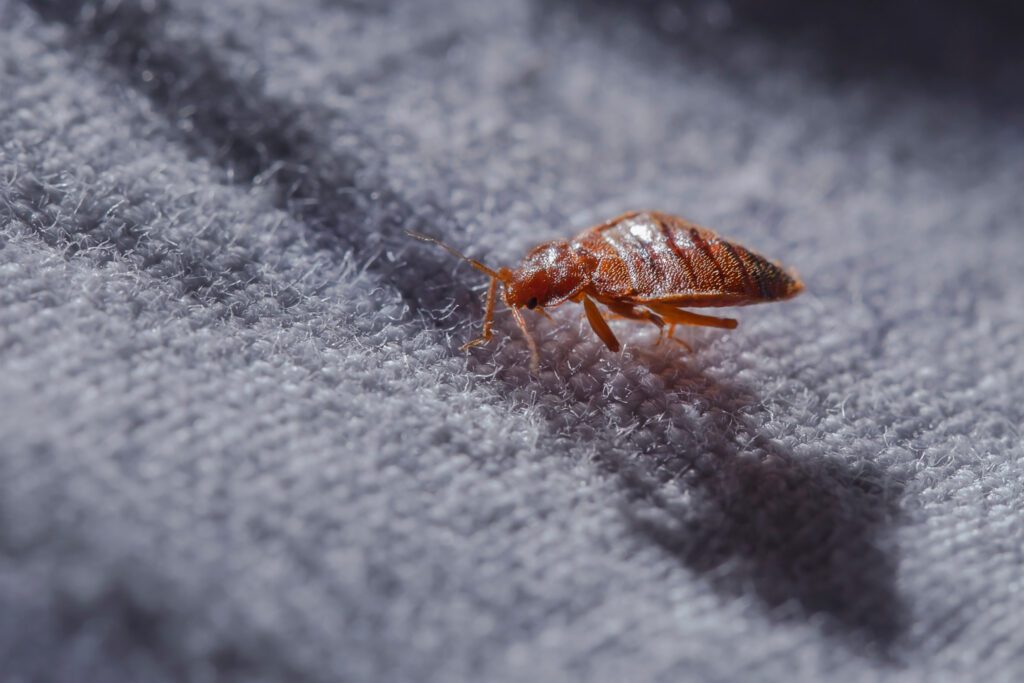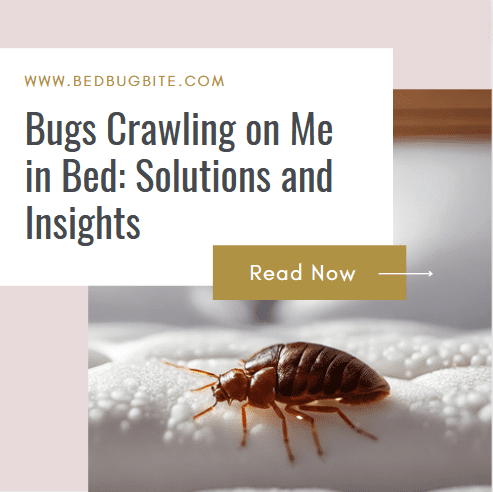Introduction
Are you lying in bed, unable to shake off the eerie sensation that bugs are bugs crawling on you, skittering across your skin? If so, you’re not alone, and the emotional toll this experience can take is not to be underestimated. The objective of this comprehensive guide is twofold. First, to dissect what could be causing this unsettling feeling. Second, to equip you with actionable steps to eradicate any potential bed bug issue that might be at its root.
As the lead writer for “Bed Bug Bite,” the internet’s top informational blog on bed bugs, rest assured you’re getting the most accurate and authoritative advice available. We’ll explore various reasons behind the feeling of creepy-crawlies on your skin. Zeroing in on bed bugs as a major culprit. From initial inspections to professional treatments, this guide offers a complete roadmap for anyone tormented by this nocturnal nightmare.
So, let’s get started and put your mind (and skin) at ease.

According to the EPA, bed bugs are masterful at hiding and their bites are not a reliable indicator of an infestation. This makes understanding the full scope of the problem even more crucial. As you can’t always rely on physical signs to diagnose the issue. By the end of this article, you’ll be well-equipped to identify if bed bugs are causing your discomfort and how to regain peaceful nights of sleep.
In the ensuing sections, we’ll delve deep into every aspect of the ‘crawling sensation.’ From scientific explanations to immediate and long-term solutions. Make sure to read through to the end for a complete understanding of this unsettling problem and its most effective solutions.
Understanding the “Crawling Sensation”
What is Formication?
Have you ever heard the term “formication”? No, it’s not a typo for “fornication.” Formication refers to the unsettling sensation that small insects or spiders are creeping on your skin. Although it might sound like a page out of a horror novel, the feeling is very real and can have a variety of causes. Ranging from psychological factors such as stress or anxiety to medical conditions like neuropathy and even menopause. While it’s easy to jump to conclusions, it’s essential to rule out these factors before attributing the sensation to bed bugs. In some cases, medical intervention may be required to resolve the issue. Bugs Crawling on Me
Could It Be Bed Bugs?
Now, let’s shift our focus to the possibility that bed bugs are the culprits causing your skin to crawl—both literally and metaphorically. These tiny bloodsuckers are infamous for their elusive nature and can wreak havoc without showing many signs. Common indicators of a bed bug infestation include small, reddish-brown bugs, tiny white eggs, and telltale bite marks in a linear or clustered pattern. If you notice any of these signs, along with the crawling sensation, you may very well be dealing with a bed bug issue.
According to a study published in the Journal of Medical Entomology, bed bugs are more likely to bite exposed areas of the body. This supports the notion that the sensation you’re feeling might not be purely psychological. Instead, it could be an early indicator of a growing bed bug problem.
In the upcoming sections, we’ll walk you through how to carry out an initial inspection for bed bugs and when to consider bringing in the professionals. Our aim is to arm you with all the necessary information to identify and treat any bed bug issues head-on.

With this foundational knowledge, you are one step closer to solving the mystery of the ‘crawling sensation’ you’ve been experiencing. In the following sections, we’ll guide you through the initial steps you should take to either confirm or rule out bed bugs as the cause. Rest assured, by the end of this comprehensive guide, you will have a well-rounded understanding of the problem and actionable solutions at your fingertips.
How to Confirm a Bed Bug Issue
Initial Inspection
Feeling the unnerving sensation of bugs crawling on you in bed is a distressing experience. One that often leads to sleepless nights. The first line of action in confronting this issue is an initial inspection. Grab a flashlight and begin scrutinizing the usual hangouts for bed bugs. The seams of your mattress, the folds in your bed linens, and even the nooks and crannies of your bed frame. Keep an eye out for live bugs. They are small and reddish-brown, as well as tiny white eggs and black fecal spots.
The United States Environmental Protection Agency EPA recommends not just relying on visible signs alone. Adult bed bugs can be elusive, and their eggs and nymphs are often even harder to spot. Thanks to their minuscule size and translucent appearance. Therefore, a close and thorough examination is crucial to determining whether bed bugs are the root cause of your crawling sensation. Bugs Crawling on Me
The Importance of Professional Inspection
While a diligent initial inspection is a critical first step, it’s just that—a first step. The intricate nature of a bed bug infestation often requires expertise for a definitive diagnosis. Professional exterminators come armed with specialized tools and knowledge that the average person may not possess. These experts utilize a range of techniques. From bed bug-sniffing dogs trained to detect the scent of these pests to UV lights that can reveal otherwise hidden signs of their presence.
Given the stakes, it’s strongly advisable to consult a professional for an in-depth analysis. They’ll not only confirm whether or not bed bugs are the culprits but will also provide a strategic plan to effectively eradicate them, tailored to your specific situation.
With this phase of inspection completed, whether DIY or professional, you’re now equipped to move on to the next logical steps. Whether that means isolating the affected area. Employing over-the-counter treatments, or opting for professional extermination services, you’ll have a targeted plan of action. In the following segments, we’ll delve into each of these options. Offering in-depth guidance on how to reclaim your bed—and peace of mind.
Immediate Steps to Contain the Problem
Isolation Techniques
Once you’ve either suspected or confirmed the presence of bed bugs, immediate action is crucial to contain the spread. Start by isolating the affected areas to minimize the bed bugs’ ability to migrate to other parts of your home. One effective method is to use mattress encasements designed to trap bed bugs inside, effectively starving them to death. Additionally, consider employing bed bug interceptors—devices placed under the legs of your bed to capture bugs attempting to climb up. These tools serve as an initial line of defense and can also help you monitor the level of infestation over time.
It’s worth noting that according to the National Pest Management Association, these isolation techniques are not standalone solutions but part of an integrated pest management strategy. This highlights the importance of using multiple approaches to effectively combat the problem. Bugs Crawling on Me
DIY Treatments
While you might be tempted to tackle the issue yourself, it’s important to be cautious when selecting over-the-counter treatments. Products like foggers and bug bombs are generally ineffective against bed bugs and could even disperse them, making the issue worse. However, there are some DIY methods that can offer temporary relief. For example, food-grade diatomaceous earth can be sprinkled around suspected areas to dehydrate the bugs, acting as a natural insecticide. Always follow the manufacturer’s guidelines to ensure that you’re using these products safely and effectively.
Through these immediate containment strategies, you’re establishing a first line of defense against the bed bug intruders. While these steps are crucial, they’re often not enough to entirely eliminate the problem. This brings us to our next point: professional extermination. As we move on, we’ll explore why turning to the pros is often the most effective long-term solution for reclaiming your sanctuary.
Professional Extermination: The Gold Standard
Why Professional Treatment is Often Necessary
When it comes to bed bugs, the unfortunate truth is that DIY methods often fall short. These pests have developed resistances to many commonly used insecticides, making it increasingly challenging to eradicate an infestation fully. Moreover, bed bugs are skilled at hiding in hard-to-reach places, often beyond the scope of common DIY treatments. This is why professional extermination is widely considered the most reliable option for fully ridding your home of these resilient bugs.
Types of Professional Treatments
Professional exterminators come armed with a variety of treatments that offer higher efficacy rates than most over-the-counter solutions. Two of the most common are heat treatment and chemical treatment. Heat treatment involves raising the temperature in the affected area to levels lethal for bed bugs but safe for your home and belongings. Chemical treatment, on the other hand, uses specialized pesticides that are both potent and targeted, ensuring a more thorough eradication.
The Centers for Disease Control and Prevention (CDC) affirm the importance of integrated pest management, which may combine these methods for greater effectiveness. With the guidance of professionals, a customized plan will be created for your unique situation, likely incorporating a mix of these treatments for best results.
The Costs Involved and Why It’s Worth It
It’s important to acknowledge that professional bed bug treatment comes with a price tag. Costs can vary depending on the extent of the infestation and the methods used. However, consider this an investment in your well-being. The physical and emotional toll of a bed bug infestation can be overwhelming. Professional treatment offers not only the best chance at complete eradication but also the peace of mind that comes with knowing the problem has been effectively dealt with.
In the long run, turning to professionals is often the most economical and efficient path to reclaiming your home from bed bugs. With this crucial step, you’re now poised to move from a reactive stance to a proactive one, ensuring that bed bugs don’t revisit your sanctuary. Our final sections will guide you through preventive measures to keep your home bed bug-free, maintaining the peace and comfort you’ve worked so hard to regain.
Prevention: Keeping Bed Bugs at Bay
The Role of Regular Monitoring
If you’ve faced a bed bug infestation, the last thing you want is a recurrence. The first pillar of prevention is regular monitoring. This involves more than a cursory glance at your mattress every once in a while. Create a weekly routine where you inspect not just your bedding but also other furniture, wall fixtures, and even electrical outlets for signs of bed bugs. Early detection is crucial for nipping any future infestations in the bud.
As endorsed by the World Health Organization, vigilance in detection practices is a cornerstone of bed bug prevention. Keeping an eye out for the telltale signs—like tiny fecal spots, shed exoskeletons, or a musty odor—can alert you to a problem before it becomes a full-blown infestation.
Importance of Sanitation and Hygiene
While bed bugs are not attracted to dirt or grime, clutter offers more hiding spots for these troublesome pests. A clean home makes it easier to spot signs of an infestation and also reduces the number of places where bed bugs can hide. Regular vacuuming, including the furniture and upholstery, can go a long way in keeping these pests at bay. Dispose of the vacuum bag in a sealed plastic bag to ensure any captured bed bugs can’t escape back into your home.
Travel Precautions
Traveling is one of the most common ways people unwittingly bring bed bugs into their homes. When staying in hotels or guesthouses, inspect the bed and surrounding areas for signs of bed bugs. Use luggage racks to keep your bags off the floor and away from the bed. Upon returning home, launder all clothing in hot water and inspect your luggage thoroughly before bringing it inside.
By incorporating these preventive measures into your daily life, you’re constructing a fortress of security against future bed bug invasions. Equipped with this comprehensive guide, you now possess the knowledge and strategies needed to not only tackle an existing bed bug issue but also to prevent future infestations. In the upcoming conclusion, we’ll summarize the key takeaways and provide you with additional resources to continue your journey towards a bed bug-free life.
Conclusion: Reclaiming Your Sanctuary from Bed Bugs
Summary of Key Takeaways
Feeling like bugs are crawling on you while you’re in bed is a dreadful sensation that unfortunately may indicate a bed bug problem. However, with a rigorous approach involving initial inspection, containment, professional extermination, and preventive measures, you can effectively combat this issue. It’s crucial to act swiftly at the first signs of trouble, and whenever possible, seek the assistance of professionals for the most reliable results.
Additional Resources
For those who wish to dive deeper into the subject, there are a plethora of resources available. Websites like the Centers for Disease Control and Prevention offer detailed guides on bed bug biology, treatments, and prevention. Books such as “The Bed Bug Book: The Complete Guide to Prevention and Extermination” by Ralph H. Maestre provide a comprehensive look at tackling these resilient pests. Online forums and social media groups also offer community support and additional tips for those dealing with an infestation.
Final Thoughts
Living with bed bugs is a situation no one wants to find themselves in, but unfortunately, these pests are a growing concern worldwide. The key to reclaiming your space lies in knowledge, prompt action, and sustained prevention efforts. Armed with the information provided in this comprehensive guide, you’re well on your way to restoring peace, comfort, and bug-free nights in your home.
By following these steps and keeping abreast of the latest developments in bed bug control, you not only protect your sanctuary but also contribute to a larger community effort in managing and ultimately reducing these troublesome infestations.




